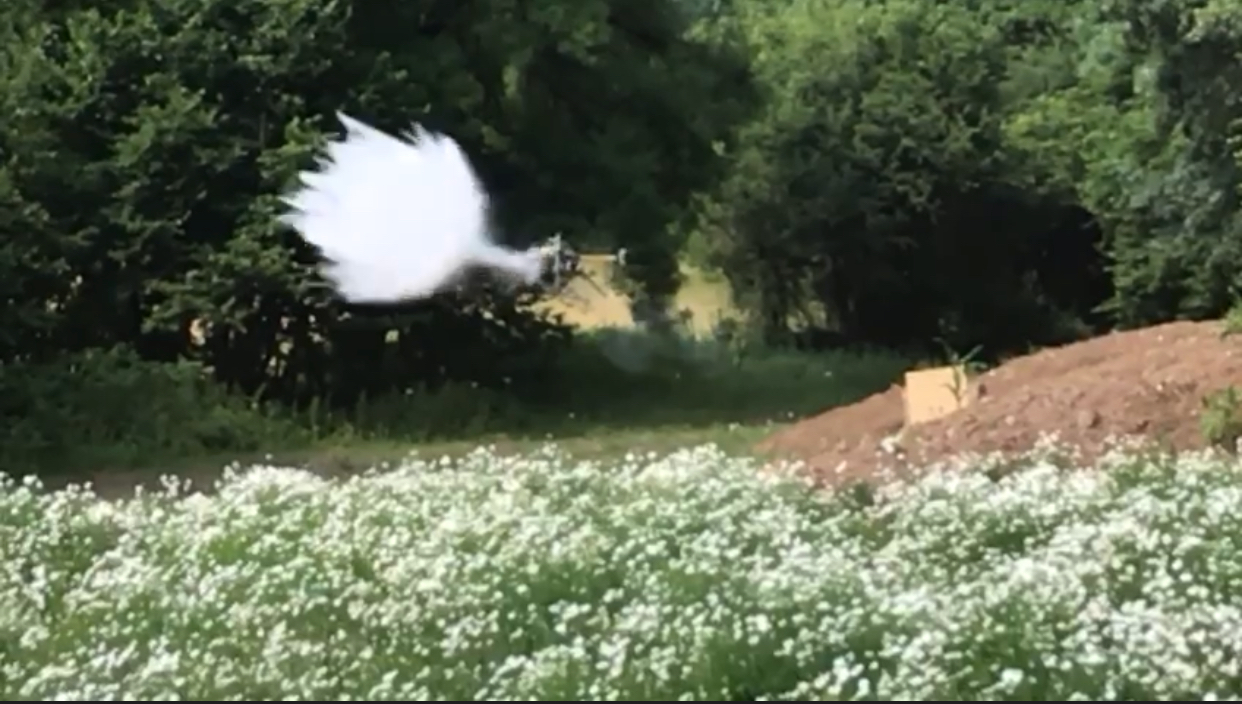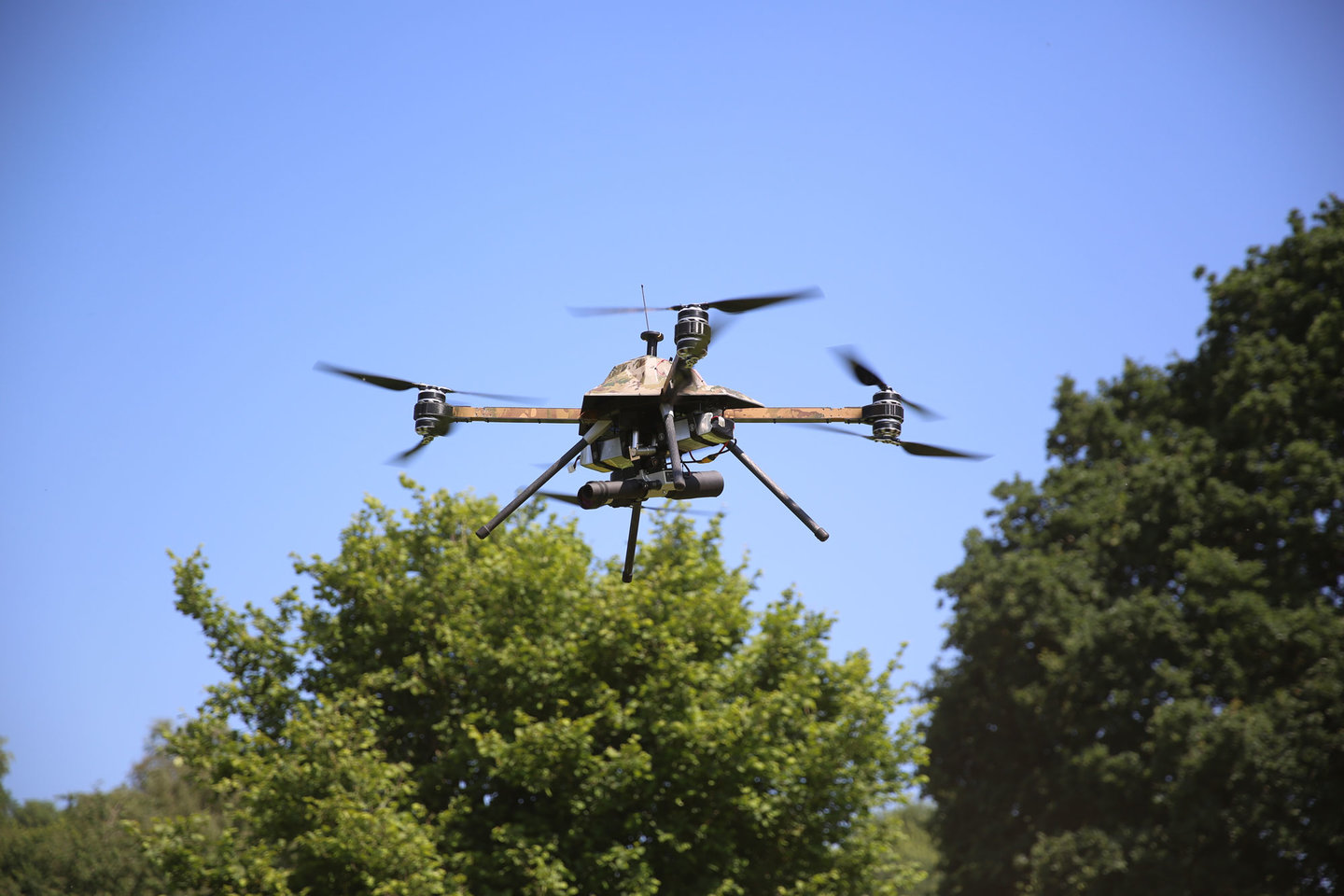Q&A | LAND
Disruptor drones: neutralising IEDs from the air
Companies are looking at innovative concepts for dealing with improvised explosive devices (ieds), including the use of drones to reduce risk to bomb disposal experts. Grant Turnbull speaks to SteelRock Technologies about its IED disruptor drone.

// Image: SteelRock Technologies
British drone developer SteelRock Technologies has partnered with Chemring Technology Solutions to develop a UAV that can neutralise IEDs from the air.
Equipped with Chemring’s RE70 M3 recoilless disruptor, which was originally designed to be deployed near the target by a bomb technician or mounted on a robot vehicle, SteelRock’s W03 Protector UAV platform offers a revolutionary solution to neutralise IEDs in difficult-to-access environments. It overcomes the limitations of traditional ground-based robots and means that personnel do not have to physically dismantle a bomb and put their lives at risk.
We talk to SteelRock Technologies chief technology officer and co-founder Christopher Hamer about the project and how it could redefine counter-IED operations.
// Grant Turnbull:
Can you tell us about the origins of this project?
// Christopher Hamer:
This is the brainchild of a former Royal Engineers bomb disposal expert, Simon Gardner, who now works with us. This project is about two years old; we initially started with Richmond Defence Systems (RDS) with their Vulcan 40mm disruptor, as an early proof of concept, and then we started working with Chermring, conducting different types of test scenarios on the firing range.
An IED disruptor is usually on a land-based platform and generally, for the British Army, are not stand off. In Afghanistan, bomb disposal experts had to regularly take apart the bombs because the robot couldn't get to it, usually because of terrain. So everything had to be done by hand, exposing the operator to significant risk.
Gardner approached us while he was still in the army, and asked us if we could develop a UAV-based solution. So we did it within five weeks from idea to a working, flying and firing prototype. What makes this unique is that it can fire from the air and from the ground as it has a gimbal underneath which can allow it to fire from either.
The disruption from the air is key, and no one has managed to do it yet – until now.

The Protector UAV fires the disruptor. Image: SteelRock Technologies
What UAV technology you are using?
We are using our SR1 UAV platform with the WO3 Protector module for this project. The most recent version of the SR1 has been improved further and is now fully waterproof. It has a special cooling system that allows it to operate in the desert without any issues and it has also got a very low downdraft, which is important when operating close to IEDs. You can even use it to dust off the surface layer on top of an IED to see what you need to do.
You can do this fully autonomously, you don’t need to have a pilot to fly it: you press the screen and it will fly there and then you can make a decision about whether you want to fire the disruptor.
The W03 refers to the modular system that goes onto the UAV - the base platform is known as the SR1 - so all our drones allow you to clip different things to them and put them in different roles whether that’s surveillance, last mile resupply, or disaster relief. The thing with our drones is they deliver lifesaving capabilities, rather than being used for offensive purposes.
What sensors and sighting systems are you using?
We have moved away from lasers for sighting, and now gone to a sighting system that allows us to target the IED without any form of lasers. Now you just line the crosshairs up with the camera sighting system on the bottom of the manifold and that’s it. It sounds simple but its high tech and it’s taken us a long time to get there.
That also gives us the ability to use object recognition, which takes us onto the other side of the WO3, which is detection of IEDs using a range of different sensors. That could be ground penetrating radar or thermal cameras, which allows you to see the difference in the ground temperature and ground density, and then you can make a decision on whether to send the drone and shoot it with the effector.

The UAV uses a Chemring RE70 M3 recoilless disruptor. Image: SteelRock Technologies
How is a UAV optimised for this type of role?
The maximum stand-off range for the disruptor is 30mm, but if the drone is high enough then it shouldn’t be damaged by the blast. The drone is large (1.2m x 1.2m) and it will take a kicking, it’s not like a small hobby drone, it’s nearly 20kg without payload.
It can also carry blast sacks - which are filled with water to mitigate both fireball and fragmentation effects - to where the IED is, so it can add an explosive protection layer prior to shooting it. The underlying technology that gives us the ability to do this is our stability algorithm. The 40mm disruptor, even though it is recoilless, it still has a hell of a whack on it but the drone works out what it needs to do prior to firing and then it counteracts the firing action, so it looks completely static during firing.
We have done extensive test firings and to this day we still have a 100% hit record.
What’s next for the technology?
This is still currently funded by SteelRock Technologies and Chemring, but we have a lot of interest at the moment, especially in Europe and armed forces and security services that are already using these disruptors on ground platforms. We have more testing coming up for the sighting system, and we are seeking partners for additional sensors for the UAV to make it a one-stop-shop for detecting and neutralising IEDs.
However, because it’s such a new technology it would require doctrinal changes and some armed forces are not fully prepared to change their explosive ordnance disposal and counter-IED doctrine just yet. And even though new EOD robots are coming into service, such as the new systems for the British Army, they will always be limited by terrain, which means a soldier will still have to get down on their hands and knees to dismantle a bomb.
To accelerate the process of the capability being adopted by the British Army and other military organisations, we are planning an extensive programme of airframe and payload certification, working closely with industry leaders in this area.